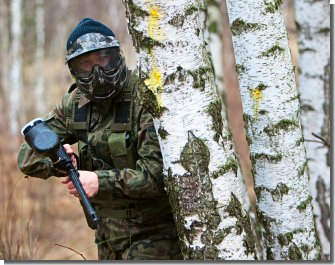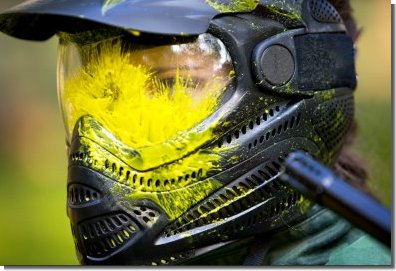Paintball Rules, Game Types, and Basic Playing Guidelines
The game of paintball is fairly simple; it just a few minutes, you can learn all the rules. But if you want to become a master player? That's still hundreds of games away.

The beauty of playing paintball is that it's always different. Each match is always fun and exciting, and that's because no two games of paintball will ever be the same.
Even if you're playing on the same fields time and time again, there will always be different opponents... different tactics... different pushes and fronts and bunker-rushes and sniper positions during the overall ebb and flow between two battling paintball teams.
Yet while the game may seem a little chaotic to the first-time player, the basic rules are etched in stone. In general, paintball is played when two different teams - identified by colored armbands - are pitted against each other from two different starting positions. The game starts and ends with the referees whistle, and in the middle, there's a hell of a lot of shooting.
Paintball Basics: How the Game is Played
In paintball, you're given a gun and assigned a team. The object is simple: shoot your opponents, and eliminate them from the game.
Depending upon the type of game being played, your goals can vary... but shooting opposing players is always the ultimate goal. Teams are usually identified by brightly-colored armbands, so you know who your allies and enemies are.

Moving to the Paintball Field
Being led to the battlefield is the first step in a paintball game. This is where you'll leave the common area and head toward the field where the actual game will take place.
Before going anywhere, your referees will call for two things: masks DOWN and barrel plugs IN. Here's where you'll make sure your mask is down, and you'll keep it down the entire time you're on the battlefield... whether the game is still going on or not.
Your barrel plug is exactly that: a plug that fits in your barrel. While in, it prevents you from shooting someone with an accidental paintball. The safety mechanism of your paintball gun should also be ON, preventing you from firing the gun in the first place.

Starting the Game - Home Base
A paintball game begins with two teams being led to opposite ends of the field. Your starting point is your home base, and this is where you'll bring the opponents flag back in order to win (in capture the flag type paintball games).
You'll generally have one referee or 'gamemaster' assigned to each team, and another referee (or two) in the center of the paintball field to call out hits. In most cases the refs will use walkie-talkies to communicate with each other, and to signal the start of the game by simultaneous whistle.
Here's where you'll be instructed to remove your barrel plug. You'll also switch your gun's safety off. Your mask should already be on.
The game begins at the whistle. Some players will spring forward to gain early position, while some will hang back to defend their base or flag. As a beginner paintballer, watch closely to see how the game develops. Don't run headfirst into an ambush on your first paintball game; relax, observe, and get behind some cover before doing anything else.

Shooting an Opponent Out of the Game
In paintball, you're allowed to shoot your opponent anywhere on his or her body. On most fields, the person is out no matter where the paintball hits them.
That being said, the paintball MUST break and scatter paint on the body in order for the hit to count.
Paintballs that bounce off without breaking do NOT count. Similiarly, paint 'splatter' that gets on you from shots that hit nearby trees or obstacles do NOT mean you're out of the game.
Shooting an opponent in the face, mask, or head is almost always legal. In fact, the head is often the only part of your opponents body that will be exposed to you, as they crouch behind a barrier.
On most paintball fields, getting shot in the gun is considered an elimination (since in real life, your gun would no longer work). On some fields however, the gun is not considered a valid target and you can continue playing within that game. The hopper part of your gun containing the paintballs, as well as your CO2 or N2 air tank, are both considered a part of your gun.

Getting Shot and Eliminated
Getting shot anywhere on your body or gun puts you out of the paintball game, as long as the paintball hitting you broke and left paint. Getting shot in the mask counts. The hand, the foot... everything counts.

If you get shot somewhere you can't see, such as the top of your head or on the back, you can call the referee for a 'paint check' to see if you were eliminated. Similarly, you can ask a teammate to do a paint check on you, or just check yourself for paint with your free hand. Remember, paint splatter from surrounding objects doesn't count: the paintball must hit you directly.
When you ARE shot and eliminated, you must immediately leave the paintball field. The best thing to do is shout a very loud "I'M OUT!!!!" and then slowly stand up with your paintball gun held high above your head. This is the standard signal for players who've been eliminated, so opponents no longer continue shooting at them.
Walk slowly toward the nearest edge or boundary of the paintball field, remembering to keep your gun held above you. Lower your gun, and you risk getting shot again. Run, and you risk the same thing.
Once you've left the paintball field do NOT remove your mask! Walk to the designated 'out' area to join other eliminated players. If there is no such area, you can watch the game finish while remaining out of bounds (and keeping your mask on, of course).

The 'Surrender' Rule (Optional)
Paintball has a built-in 'surrender' rule to keep people from being shot at close range. This prevents a lot of injuries and nasty paintball welts, so be courteous by using it when coming up on someone's blind side.
Most surrendering occurs when you bunker-rush someone. This means you run up on an opponent who's hiding behind a bunker, tree, or other obstacle. Since they don't see you coming, you're suddenly right up next to them or on top of them without them knowing it.
To eliminate this opponent, point your gun at them and shout "SURRENDER!" as loudly as possible.
NOTE: The opponent is not required to surrender. If they don't immediately put their hands up and shout themselves out, it's okay for you to open fire. Don't unleash too many shots though, because at very close range paintballs can be very painful.
Be advised that it's always best to surrender yourself when an opponent rushes up on you blindly. Although you have the right to fire and keep playing, odds are good you'll both end up eliminating each other, as well as cover each other with blood-red welts in the process.

The End of the Game
A paintball game ends when one team is wiped out or eliminated, or when a particular goal such as capturing an opponent's flag has been achieved. The referee will blow a whistle signifying the end of the game, at which point any remaining players will leave the paintball field.
Even after the game has ended, do NOT remove your mask. There may still be games going on around you, and paintballs could still come flying from surrounding fields.

Summing Things Up - Paintball Basics to Remember
The following guidelines are important while playing paintball. Whether you're a beginning player or an established expert, make sure you know them:
- Keep Your Mask on at All Times
- Don't Shoot at The Refs
- Use the Surrender Rule Where Possible
- Don't Be a Hero
- Stick Together With Your Allies
- Watch For Friendly Fire
- Don't Fire Blind
This is the single most important part of playing paintball. The only time your mask should be off is in the common or 'safe' area. On the battlefield, it should always be ON. Even if you've been shot out, and even if you're just watching from the sidelines.
Seems like it goes without saying, but I've seen LOTS of people get way too trigger-happy. Referees are usually identified by brightly-colored yellow or orange vests. Shooting them, even accidentally, will usually get you thrown out of a game.
Surrendering is always a good idea. On the flip side of the coin, offering surrender is always better than blasting an opponent with a volley of paintballs from 5 or 10 feet away. Remember: you have to see this guy again once the masks are lifted.
As a beginner, it's easy to get caught out of position in a paintball game. One minute you think you're surrounded by teammates, and the next you find yourself deep behind enemy lines.
This is where you'll end up getting hurt; when six people are shooting at you all at once. Learning when to advance forward in a paintball game - and when to hang back - is something that only comes with experience. So in the beginning? Keep the heroics to a minimum.
In war, there's strength in numbers. So even on the biggest and widest of paintball fields, it's always good to stay close to a buddy or two.
Sticking together allows you to have extra firepower, extra sets of eyes, and extra flanking ability when moving up on an enemy position. Staying with teammates also allows you to see how other paintballers play; you can analyze their moves, their tactics, and their general knowledge of the game.
In paintball, friendly fire counts. You can be eliminated by players on your own team, and you can accidentally shoot out your friends and allies if you're not paying attention.
Believe it or not, friendly fire happens a lot more often than you might think. In the heat of battle, when you're unleashing hundreds of paintballs at once? It's very easy to get confused. It's also easy to run in front of one of your teammates who already happens to be firing on a position.
Blind firing, or firing over (or around) an obstacle without looking, is almost always prohibited in paintball. This is because you can hit already-eliminated players, referees, teammates, or whatever. It's also a waste of paint.
Click Here to See Different Types of Paintball Games
